Land Use/Cover Change, Fragmentation, and Driving Factors in Nepal in the Last 25 Years
Abstract
:1. Introduction
2. Materials and Methods
2.1. Study Area
2.2. Forests in Nepal
2.3. Key Economic Indicators and Population of Nepal
2.4. Data
2.5. Methods
2.5.1. Data Pre-Processing
2.5.2. Land Use/Cover Transfer Matrix
2.5.3. Land Use Type Dynamic Degree
2.5.4. Land Use/Cover Fragmentation Index
2.5.5. Spatial Aggregation Analysis
2.5.6. Driving Factor Selection
2.5.7. Analysis of Driving Factors
3. Results
3.1. Characteristics of Land Use/Cover Transfer in Nepal
3.1.1. Area and Direction of Land Use/Cover Transfer
3.1.2. Transfer Magnitude and Speed
3.2. Analysis of Spatial Agglomeration of Land Use/Cover in Nepal
3.2.1. Land Fragmentation
3.2.2. Spatial Aggregation Analysis
3.3. Analysis of Land Use/Cover Drivers in Nepal
3.3.1. Principal Component Analysis
3.3.2. Regression Analysis of Forest Drivers
4. Discussion
4.1. Driving Factors Influencing the Forests
4.2. Community Forestry of Nepal
4.3. Possible Factors Affecting Land Fragmentation
5. Conclusions
Author Contributions
Funding
Institutional Review Board Statement
Informed Consent Statement
Data Availability Statement
Acknowledgments
Conflicts of Interest
References
- Sutherst, R.W. Implications of global change and climate variability for vector-borne diseases: Generic approaches to impact assessments. Int. J. Parasitol. 1998, 28, 935–945. [Google Scholar] [CrossRef] [PubMed]
- Scherm, H.; Sutherst, R.W.; Harrington, R.; Ingram, J.S.I. Global networking for assessment of impacts of global change on plant pests. Environ. Pollut. 2000, 108, 333–341. [Google Scholar] [CrossRef] [PubMed]
- Peng, J.; Xu, Y.Q.; Cai, Y.L.; Xiao, H.L. Climatic and anthropogenic drivers of land use/cover change in fragile karst areas of southwest China since the early 1970s: A case study on the Maotiaohe watershed. Environ. Earth Sci. 2011, 64, 2107–2118. [Google Scholar] [CrossRef]
- Nyelele, C.; Murwira, A.; Dube, T. Understanding the impacts of human resettlement and projected land use dynamics in Chimanimani district of Zimbabwe. Phys. Chem. Earth 2018, 106, 83–88. [Google Scholar] [CrossRef]
- Fan, S.Z.; Weng, A.F.; Zhou, W.; Lan, S.R.; Liao, L.Y.; Xiu, X.T. Analysis of land use changes and driving forces in suburban scenic spots and surrounding areas—Taking Fenghuangshan scenic spot in Putian city, Fujian province as an example. For. Econ. 2021, 43, 55–76. [Google Scholar] [CrossRef]
- Zhao, Y.Q.; Li, R.D.; Wu, M.Q. Correlation studies between land cover change and Baidu index: A case study of Hubei Province. ISPRS Int. J. Geo-Inf. 2020, 9, 232. [Google Scholar] [CrossRef]
- Arowolo, A.O.; Deng, X.Z. Land use/land cover change and statistical modelling of cultivated land change drivers in Nigeria. Reg. Environ. Chang. 2018, 18, 247–259. [Google Scholar] [CrossRef]
- Liu, W.; Zhan, J.Y.; Zhao, F.; Yan, H.M.; Zhang, F.; Wei, X.Q. Impacts of urbanization-induced land-use changes on ecosystem services: A case study of the Pearl River Delta Metropolitan Region, China. Ecol. Indic. 2019, 98, 228–238. [Google Scholar] [CrossRef]
- Yang, L.Y.; Sun, Z.H.; Li, J.F.; Shi, L.; Kong, H.; Yang, Y.Y.; Li, T. Spatiotemporal patterns and driving forces of land-use and land-cover change in the Mu Us Sandy Land, China from 1980 to 2018. Arid Land Res. Manag. 2022, 36, 109–124. [Google Scholar] [CrossRef]
- Wang, T.; Lu, F.Q.; Li, Z.Z. Study on vegetation landscape connectivity of Changzhou City based on remote sensing data. J. For. Environ. 2021, 41, 188–197. [Google Scholar] [CrossRef]
- Shimrah, T.; Lungleng, P.; Devi, A.R.; Sarma, K.; Varah, F.; Khuman, Y.S. Spatio-temporal assessment on land use and land cover (LULC) and forest fragmentation in shifting agroecosystem landscape in Ukhrul district of Manipur, Northeast India. Environ. Monit. Assess. 2022, 194, 1–13. [Google Scholar] [CrossRef]
- Winkler, K.; Fuchs, R.; Rounsevell, M.; Herold, M. Global land use changes are four times greater than previously estimated. Nat. Commun. 2021, 12, 2501. [Google Scholar] [CrossRef]
- Abdullah, S.A.; Nakagoshi, N. Forest fragmentation and its correlation to human land use change in the state of Selangor, peninsular Malaysia. For. Ecol. Manag. 2007, 241, 39–48. [Google Scholar] [CrossRef]
- Davis, K.F.; Koo, H.I.; Dell’Angelo, J.; D’Odorico, P.; Estes, L.; Kehoe, L.J.; Kharratzadeh, M.; Kuemmerle, T.; Machava, D.; Pais, A.D.R.; et al. Tropical forest loss enhanced by large-scale land acquisitions. Nat. Geosci. 2020, 13, 482–488. [Google Scholar] [CrossRef]
- Yang, C.; Liu, H.Z.; Li, Q.Q.; Cui, A.H.; Xia, R.L.; Shi, T.Z.; Zhang, J.; Gao, W.X.; Zhou, X.; Wu, G.F. Rapid urbanization induced extensive forest loss to urban land in the Guangdong-Hong Kong-Macao Greater Bay Area, China. Chin. Geogr. Sci. 2021, 31, 93–108. [Google Scholar] [CrossRef]
- Zhou, W.Q.; Zhang, S.; Yu, W.J.; Wang, J.; Wang, W.M. Effects of Urban Expansion on Forest Loss and Fragmentation in Six Megaregions, China. Remote Sens. 2017, 9, 991. [Google Scholar] [CrossRef]
- Chen, A.F.; Chen, A.P.; Varis, O.; Chen, D.L. Large net forest loss in Cambodia’s Tonle Sap Lake protected areas during 1992–2019. Ambio 2022, 51, 1889–1903. [Google Scholar] [CrossRef] [PubMed]
- Zeng, Z.Z.; Gower, D.B.; Wood, E.F. Accelerating forest loss in Southeast Asian Massif in the 21st century: A case study in Nan Province, Thailand. Glob. Chang. Biol. 2018, 24, 4682–4695. [Google Scholar] [CrossRef]
- Dong, Y.L.; Ren, Z.B.; Wang, Z.M.; Yu, Q.Y.; Zhu, L.; Yu, H.; Bao, G.D. Spatiotemporal patterns of forest changes in Korean Peninsula using landsat images during 1990-2015: A comparative study of two neighboring countries. IEEE Access 2020, 8, 73623–73633. [Google Scholar] [CrossRef]
- Reddy, C.S.; Pasha, S.V.; Satish, K.V.; Saranya, K.R.L.; Jha, C.S.; Murthy, Y.V.N.K. Quantifying nationwide land cover and historical changes in forests of Nepal (1930–2014): Implications on forest fragmentation. Biodivers. Conserv. 2018, 27, 91–107. [Google Scholar] [CrossRef]
- Chakraborty, A.; Ghosh, A.; Sachdeva, K.; Joshi, P.K. Characterizing fragmentation trends of the Himalayan forests in the Kumaon region of Uttarakhand, India. Ecol. Inform. 2017, 38, 95–109. [Google Scholar] [CrossRef]
- Cao, Q.; Chen, X.P.; Shi, M.J.; Yao, Y. Land use/cover changes and main-factor driving force in Heihe middle reaches. Trans. Chin. Soc. Agric. Eng. 2014, 30, 220–227. [Google Scholar] [CrossRef]
- Shi, G.; Jiang, N.; Yao, L.Q. Land Use and Cover Change during the Rapid Economic Growth Period from 1990 to 2010: A Case Study of Shanghai. Sustainability 2018, 10, 426. [Google Scholar] [CrossRef]
- Zhang, X.Y. Analysis of land use variation and driving forces in Western Liaoning Province from 1990 to 2020. Radio Eng. 2021, 51, 711–719. [Google Scholar] [CrossRef]
- Tiwari, K.R.; Sitaula, B.K.; Bajracharya, R.M.; Raut, N.; Bhusal, P.; Sengel, M. Vulnerability of pastoralism: A case study from the high mountains of Nepal. Sustainability 2020, 12, 2737. [Google Scholar] [CrossRef]
- Pokharel, R.K. Factors influencing the management regime of Nepal’s community forestry. For. Policy Econ. 2012, 17, 13–17. [Google Scholar] [CrossRef]
- Li, S.C.; He, F.N.; Liu, X.; Hua, L. Historical land use reconstruction for South Asia: Current understanding, challenges, and solutions. Earth-Sci. Rev. 2023, 238, 104350. [Google Scholar] [CrossRef]
- Paudel, B.; Zhang, Y.L.; Li, S.C.; Liu, L.S.; Wu, X.; Khanal, N.R. Review of studies on land use and land cover change in Nepal. J. Mt. Sci. 2016, 13, 643–660. [Google Scholar] [CrossRef]
- Paudel, B.; Zhang, Y.L.; Li, S.C.; Liu, L.S. Spatiotemporal changes in agricultural land cover in Nepal over the last 100 years. J. Geogr. Sci. 2018, 28, 1519–1537. [Google Scholar] [CrossRef]
- Rimal, B.; Sloan, S.; Keshtkar, H.; Sharma, R.; Rijal, S.; Shrestha, U.B. Patterns of historical and future urban expansion in Nepal. Remote Sens. 2020, 12, 628. [Google Scholar] [CrossRef]
- Wang, S.W.; Gebru, B.M.; Lamchin, M.; Kayastha, R.B.; Lee, W.K. Land use and land cover change detection and prediction in the Kathmandu district of Nepal using remote sensing and GIS. Sustainability 2020, 12, 3925. [Google Scholar] [CrossRef]
- Uddin, K.; Matin, M.A.; Maharjan, S. Assessment of land cover change and its impact on changes in soil erosion Risk in Nepal. Sustainability 2018, 10, 4715. [Google Scholar] [CrossRef]
- Xu, X.M.; Jain, A.K.; Calvin, K.V. Quantifying the biophysical and socioeconomic drivers of changes in forest and agricultural land in South and Southeast Asia. Glob. Chang. Biol. 2019, 25, 2137–2151. [Google Scholar] [CrossRef]
- Blaikie, P.M.; Sadeque, S.Z. Policy in High Places: Environment and Development in the Himalayan Region; ICIMOD: Kathmandu, Nepal, 2000. [Google Scholar]
- Xu, Z.W. Assessing the Impact of Climate Change on Forest Fire in Nepal Based on Time Series Remote Sensing Data. Master’s Thesis, JiangXi University of Science and Technology, Ganzhou, China, 2019. [Google Scholar]
- CBS. Nepal Statistical Year Book 2019; Central Bureau of Statistics: Kathmandu, Nepal, 2019.
- Adhikari, S.B. Policy Impact Analysis of Agriculture Policies for Food Security and Income of Small Holder Farmers in Nepal: A Multi Market Model. Ph.D. Thesis, Chinese Academy of Agricultural Sciences, Beijng, China, 2018. [Google Scholar]
- Cao, X.M.; Ai, A.N.; Lei, G.B.; Tan, J.B.; Zhang, Z.J.; Yan, D.; Xie, H.; Zhang, S.Q.; Yang, Y.S.; Sun, M.J. Land cover mapping and spatial pattern analysis with remote sensing in Nepal. J. Geo-Inf. Sci. 2016, 18, 1384–1398. [Google Scholar]
- Bhattarai, B. Community forest and forest management in Nepal. Am. J. Environ. Prot. 2016, 4, 79–91. [Google Scholar] [CrossRef]
- Tsendbazar, N.-E.; De Bruin, S.; Fritz, S.; Herold, M. Spatial accuracy assessment and integration of global land cover datasets. Remote Sens. 2015, 7, 15804–15821. [Google Scholar] [CrossRef]
- Li, W.; MacBean, N.; Ciais, P.; Defourny, P.; Lamarche, C.; Bontemps, S.; Houghton, R.A.; Peng, S.S. Gross and net land cover changes in the main plant functional types derived from the annual ESA CCI land cover maps (1992–2015). Earth Syst. Sci. Data 2018, 10, 219–234. [Google Scholar] [CrossRef]
- Liu, X.X.; Yu, L.; Si, Y.L.; Zhang, C.; Lu, H.; Yu, C.Q.; Gong, P. Identifying patterns and hotspots of global land cover transitions using the ESA CCI land cover dataset. Remote Sens. Lett. 2018, 9, 972–981. [Google Scholar] [CrossRef]
- Georgievski, G.; Hagemann, S. Characterizing uncertainties in the ESA-CCI land cover map of the epoch 2010 and their impacts on MPI-ESM climate simulations. Theor. Appl. Climatol. 2019, 137, 1587–1603. [Google Scholar] [CrossRef]
- Song, H.L.; Zhang, X.N. Precision validation of multi-sources land cover products derived from remote sensing. Remote Sens. Land Resour. 2018, 30, 26–32. [Google Scholar]
- Huang, J.; Huang, H.S.; Zhong, H.Y.; Zhang, H.T.; Shao, X.X. Provincial-scale applicability analysis of land cover data at different resolutions—Case study of Jiangxi province. Jiangxi Sci. 2021, 39, 534–540+551. [Google Scholar] [CrossRef]
- Chirachawala, C.; Shrestha, S.; Babel, M.S.; Virdis, S.G.P.; Wichakul, S. Evaluation of global land use/land cover products for hydrologic simulation in the Upper Yom River Basin, Thailand. Sci. Total Environ. 2020, 708, 135148. [Google Scholar] [CrossRef] [PubMed]
- An, M.L.; Zhang, B.; Sun, L.W.; Zhang, T.F.; Yang, B.; WAng, D.; Zhang, C.L. Quantitative analysis of dynamic change of land use and its influencing factors in upper reaches of the Heihe river. J. Glaciol. Geocryl. 2013, 35, 355–363. [Google Scholar] [CrossRef]
- Zhu, H.Y.; Li, X.B. Discussion o the Index Method of Regional Land Use Change. Acta Geogr. Sin. 2003, 58, 643–650. [Google Scholar]
- Hu, X.; Yang, D.; Shi, S.E.; Li, X. Fragmentation process and habitat quality assessment of wetland landscape in Gansu Section of Heihe River Basin. J. Hydroelectr. Eng. 2019, 38, 119–135. [Google Scholar]
- Fu, F.; Deng, S.M.; Wu, D.; Liu, W.W.; Bai, Z.H. Research on the spatiotemporal evolution of land use landscape pattern in a county area based on CA-Markov model. Sustain. Cities Soc. 2022, 80, 103760. [Google Scholar] [CrossRef]
- Zhao, X.J.; Wang, J.; Su, J.D.; Sun, W.; Jin, W.Q. Assessment of habitat quality and degradation degree based on InVEST model and Moran index in Gansu Province, China. Trans. Chin. Soc. Agric. Eng. 2020, 36, 301–308. [Google Scholar]
- Xie, F.D.; Wu, X.; Liu, L.S.; Zhang, Y.L.; Paudel, B. Land use and land cover change within the Koshi River Basin of the central Himalayas since 1990. J. Mt. Sci. 2021, 18, 159–177. [Google Scholar] [CrossRef]
- Rijal, S.; Techato, K.; Gyawali, S.; Stork, N.; Dangal, M.R.; Sinutok, S. Forest cover change and ecosystem services: A case study of community forest in Mechinagar and Buddhashanti Landscape (MBL), Nepal. J. Environ. Manag. 2021, 67, 963–973. [Google Scholar] [CrossRef]
- Qiu, G.F.; Ma, B. Land use change characteristics and their driving factors in Republic of Rwanda. Bull. Soil Water Conserv. 2022, 42, 263–273. [Google Scholar] [CrossRef]
- Bista, R.; Parajuli, R.; Giri, K.; Karki, R.; Song, C. Impacts of COVID-19 pandemic on the livelihoods of rural households in the community forestry landscape in the Middle Hills of Nepal. Trees For. People 2022, 9, 100312. [Google Scholar] [CrossRef] [PubMed]
- Sigdel, S.R.; Dawadi, B.; Camarero, J.J.; Liang, E.; Leavitt, S.W. Moisture-Limited Tree Growth for a Subtropical Himalayan Conifer Forest in Western Nepal. Forests 2018, 9, 340. [Google Scholar] [CrossRef]
- Bastakoti, R.R.; Davidsen, C. REDD+ and forest tenure security: Concerns in Nepal’s community forestry. Int. J. Sustain. Dev. World Ecol. 2014, 21, 168–180. [Google Scholar] [CrossRef]
- Stapp, J.R.; Lilieholm, R.J.; Leahy, J.; Upadhaya, S. Linking attitudes, policy, and forest cover change in buffer zone communities of Chitwan national park, Nepal. J. Environ. Manag. 2016, 57, 1292–1303. [Google Scholar] [CrossRef] [PubMed]
- Phelps, J.; Friess, D.A.; Webb, E.L. Win–win REDD+ approaches belie carbon–biodiversity trade-offs. Biol. Conserv. 2012, 154, 53–60. [Google Scholar] [CrossRef]
- Bhattarai, K.; Yousef, M.; Greife, A.; Naraharisetti, S.C.S. Influence of Topography on Sustainable Land Management: An Analysis of Socioeconomic and Ecodemographic Conditions of Nepal. Agriculture 2020, 10, 224. [Google Scholar] [CrossRef]
- Fang, Z.; Ding, T.H.; Chen, J.Y.; Xue, S.; Zhou, Q.; Wang, Y.D.; Wang, Y.X.; Huang, Z.D.; Yang, S.L. Impacts of land use/land cover changes on ecosystem services in ecologically fragile regions. Sci. Total Environ. 2022, 831, 154967. [Google Scholar] [CrossRef] [PubMed]
- Baynes, J.; Herbohn, J.; Smith, C.; Fisher, R.; Bray, D. Key factors which influence the success of community forestry in developing countries. Glob. Environ. Chang.-Hum. Policy Dimens. 2015, 35, 226–238. [Google Scholar] [CrossRef]
- Bhattarai, S.; Pant, B.; Laudari, H.K.; Rai, R.K.; Mukul, S.A. Strategic pathways to scale up forest and landscape restoration: Insights from Nepal’s tarai. Sustainability 2021, 13, 5237. [Google Scholar] [CrossRef]
- Shrestha, S.; Shrestha, U.B.; Bawa, K. Socio-economic factors and management regimes as drivers of tree cover change in Nepal. PeerJ 2018, 6, e4855. [Google Scholar] [CrossRef]
- Ghimire, C. Hydrological Impacts of Reforesting Degraded Pasture Land in the Middle Mountain Zone of Central Nepal. Ph.D. Thesis, University of Twente, Enschede, The Netherlands, 2014. [Google Scholar] [CrossRef]
- Stapp, J.R.; Lilieholm, R.J.; Upadhaya, S.; Johnson, T. Evaluating the impacts of forest management policies and community-level institutions in the buffer zone of Chitwan National Park, Nepal. J. Sustain. For. 2015, 34, 445–464. [Google Scholar] [CrossRef]
- Devkota, B.P.; Mustalahti, I. Complexities in accessing REDD plus benefits in community forestry: Evidence from Nepal’s Terai region. Int. For. Rev. 2018, 20, 332–345. [Google Scholar] [CrossRef]
- Nepal, M.; Nepal, A.K.; Berrens, R.P. Where gathering firewood matters: Proximity and forest management effects in hedonic pricing models for rural Nepal. J. For. Econ. 2017, 27, 28–37. [Google Scholar] [CrossRef]
- Acharya, K.; Talpa, N.; Halalisan, A.F.; Popa, B. The Way Forward for Community Forestry in Nepal: Analysis of Performance against National Forestry Goals. Forests 2022, 13, 726. [Google Scholar] [CrossRef]
- Sapkota, L.M.; Dhungana, H.; Poudyal, B.H.; Chapagain, B.; Gritten, D. Understanding the barriers to community forestry delivering on its potential: An illustration from two Heterogeneous districts in Nepal. J. Environ. Manag. 2020, 65, 463–477. [Google Scholar] [CrossRef] [PubMed]
- Niroula, G.S.; Thapa, G.B. Impacts and causes of land fragmentation, and lessons learned from land consolidation in South Asia. Land Use Policy 2005, 22, 358–372. [Google Scholar] [CrossRef]
- Air, B.S. Status of Parcel Fragmentation in Nepal. J. Geoinform. Nepal 2022, 51–63. [Google Scholar] [CrossRef]



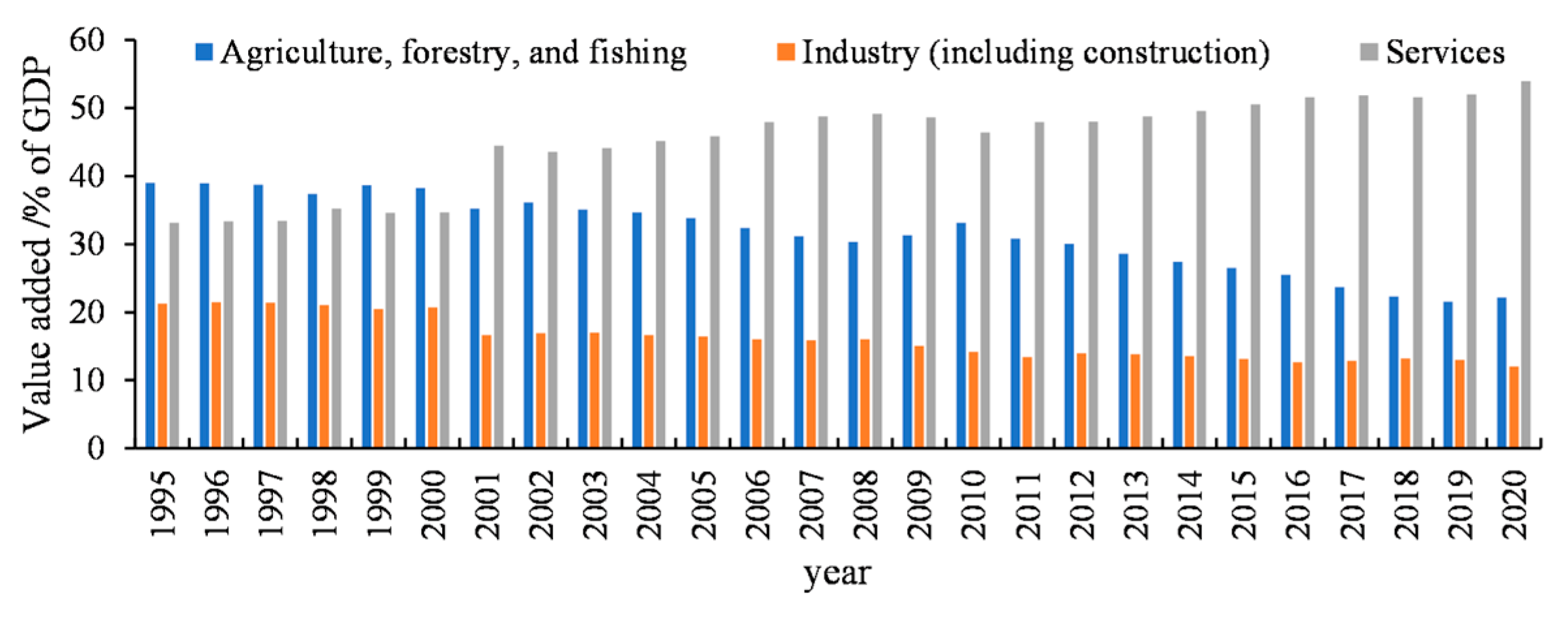
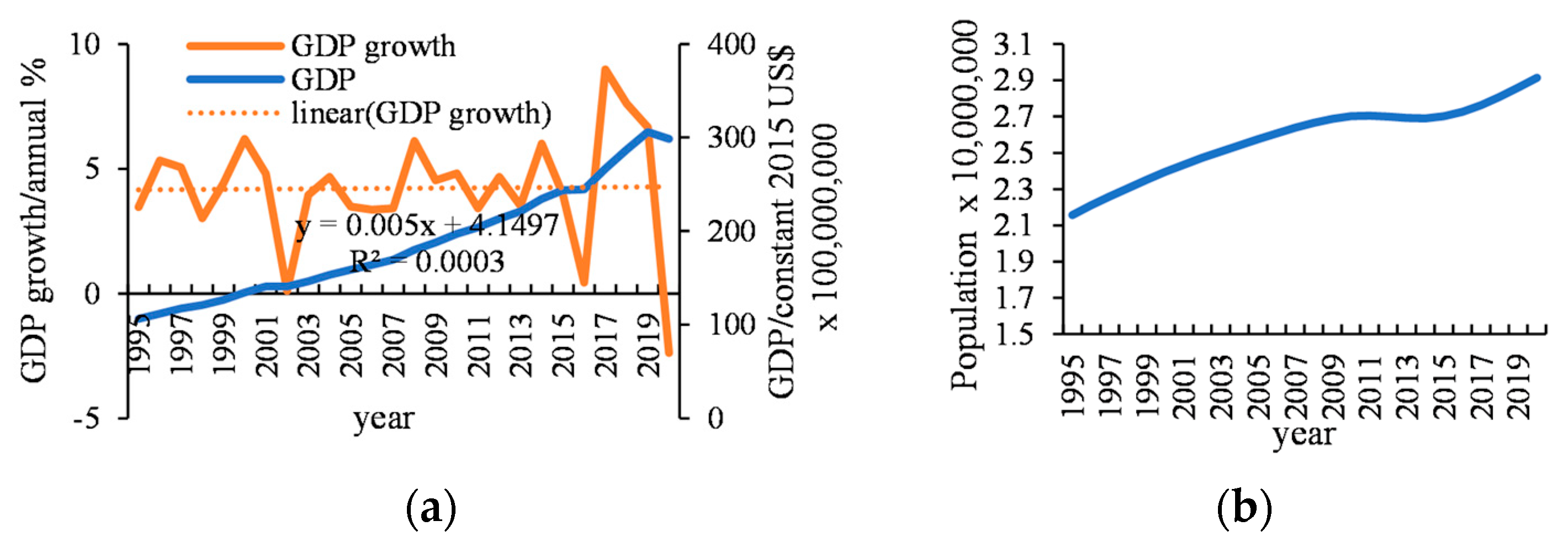
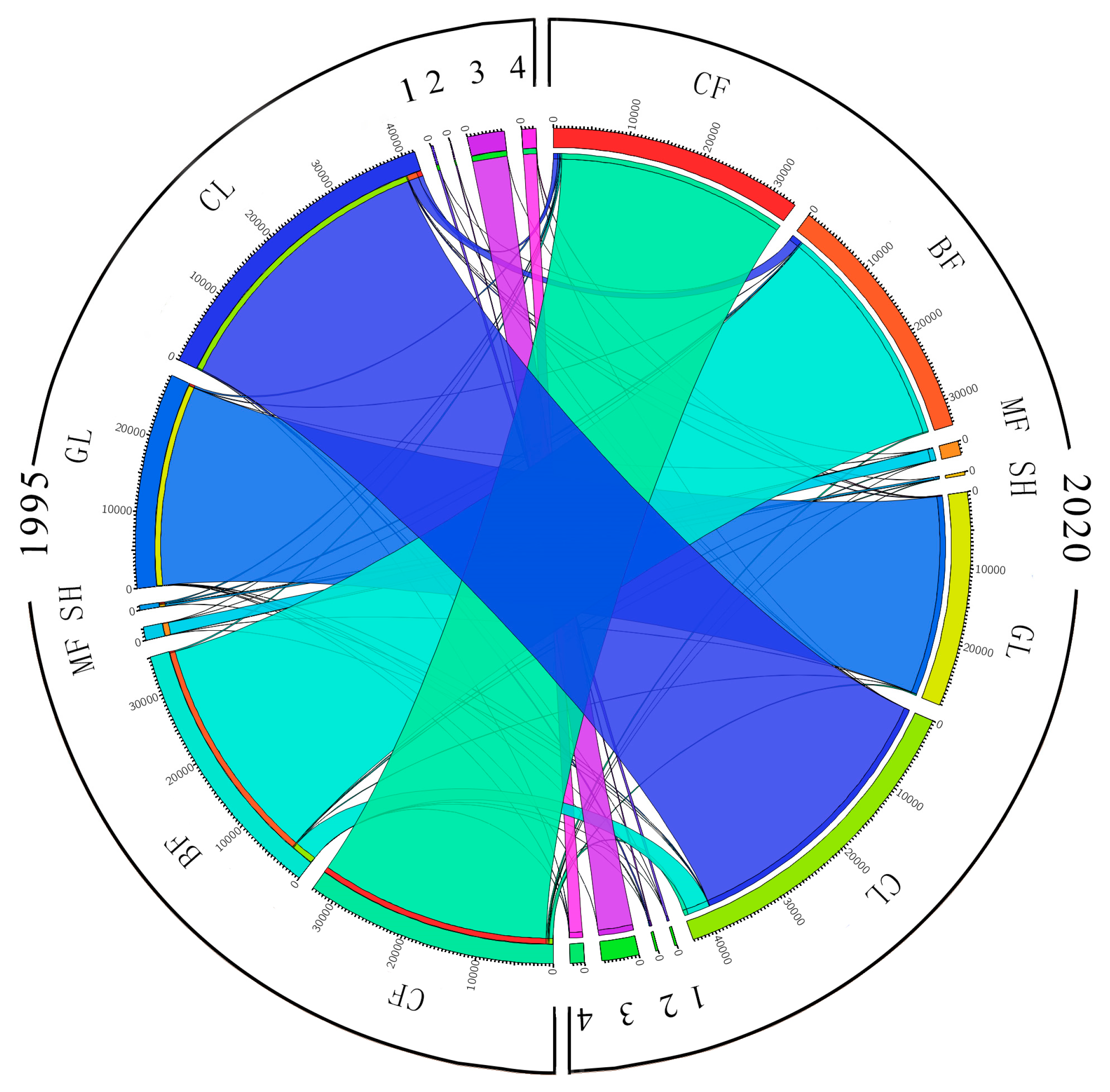
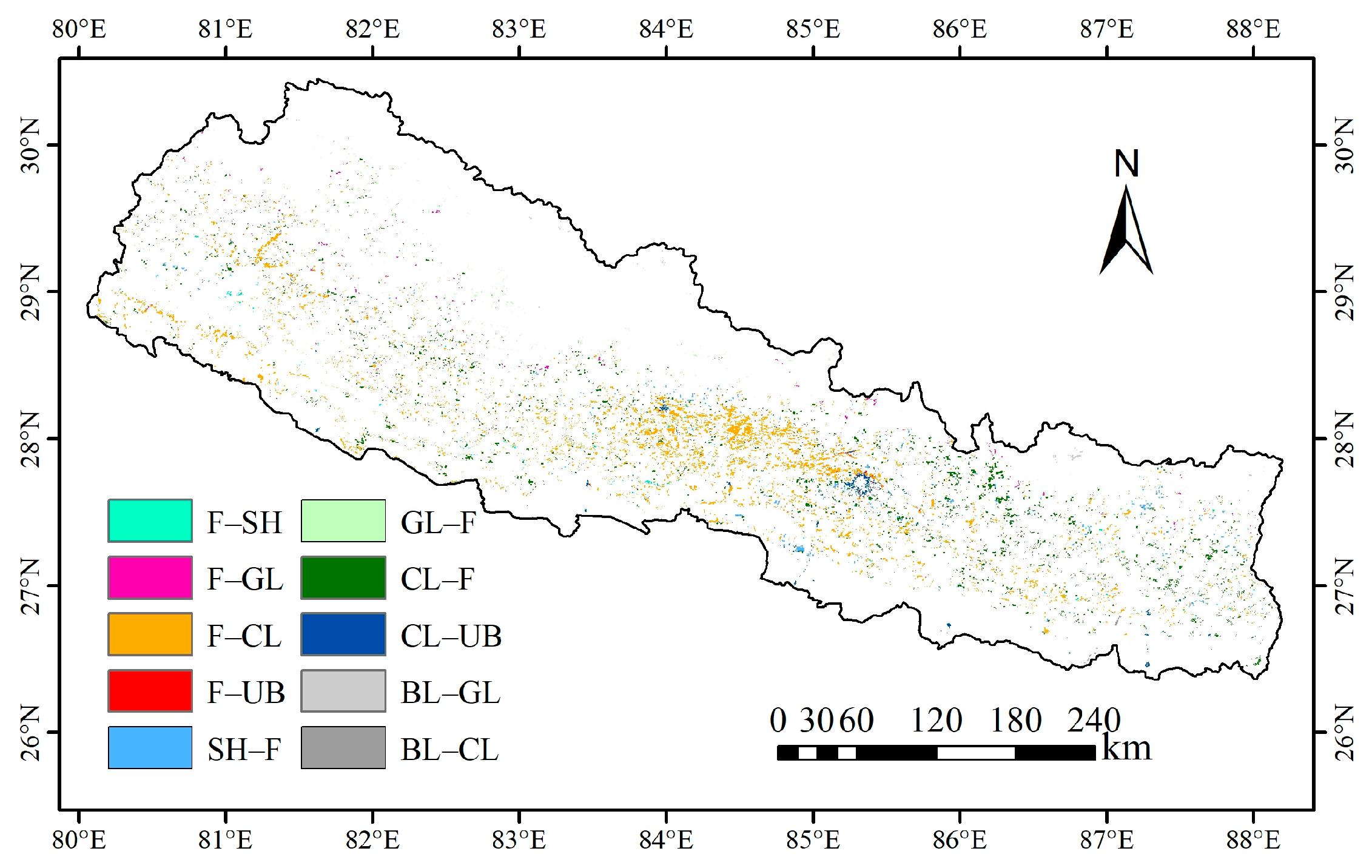

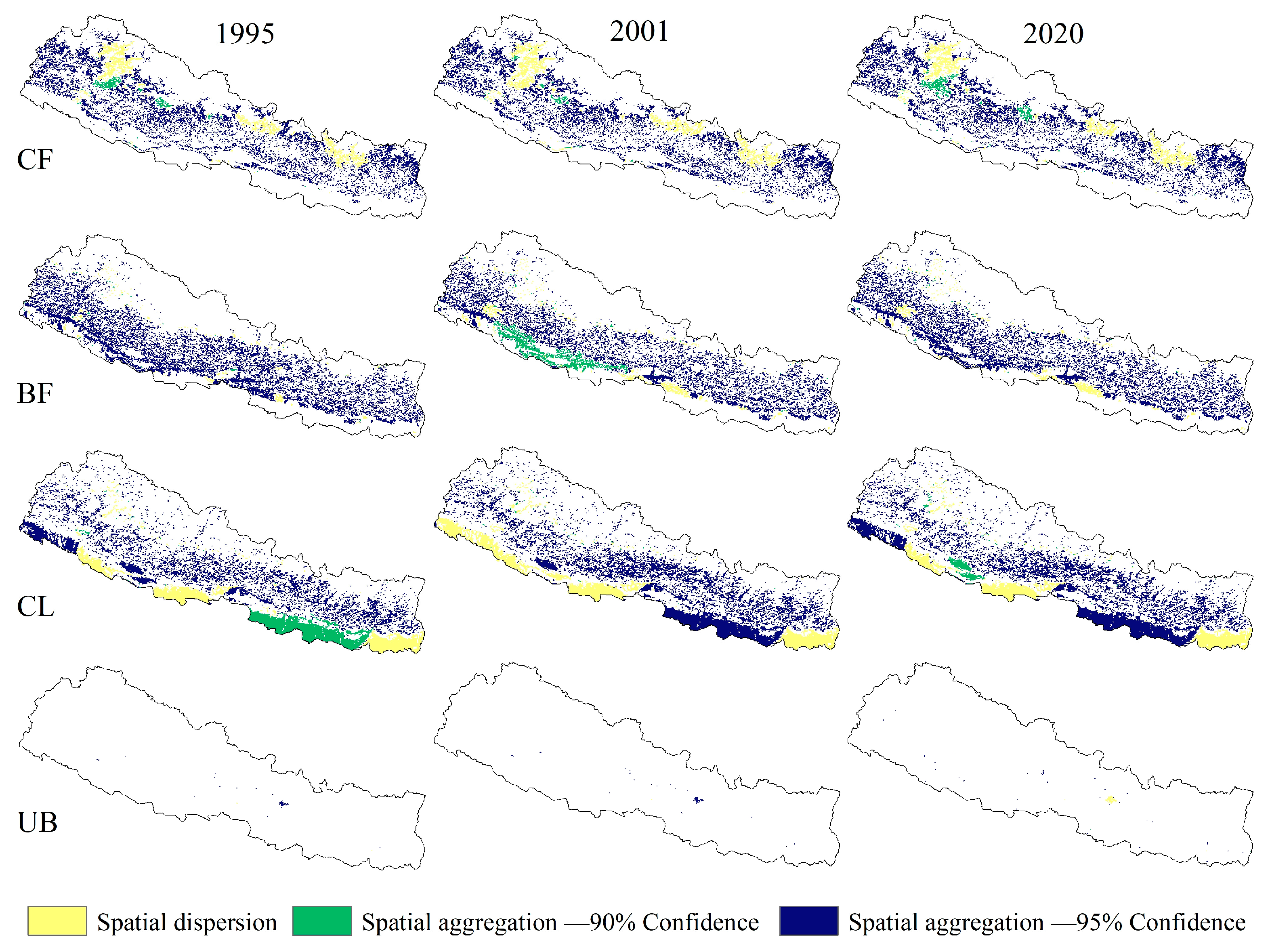
| Data Type | Source | Download Address |
|---|---|---|
| LUCC | ESA/CCI | http://maps.elie.ucl.ac.be/CCI accessed on 13 January 2023 |
| Elevation data | SRTM 90 m | https://www.resdc.cn/data.aspx?DATAID=284 accessed on 19 December 2022 |
| Statistical data | World Bank | https://data.worldbank.org/country accessed on 9 January 2023 |
| Meteorological data | ERA5-Land | https://cds.climate.copernicus.eu/cdsapp#!/dataset/reanalysis-era5-land-monthly-means?tab=overview accessed on 14 February 2023 |
| Land Cover Types | Value of ESA/CCI 1 |
|---|---|
| Coniferous forest | 70, 80 |
| Broadleaf forest | 50, 60 |
| Mixed forest | 90, 100, 110 |
| Shrub | 120 |
| Grassland | 130, 140 |
| Cropland | 10, 20, 30, 40 |
| Wetland water | 160, 170, 180 |
| Construction land | 190 |
| Permanent snow and ice | 220 |
| Bare land | 150, 200 |
| Landscape Fragmentation Index | Abbreviation | Range | Ecological Significance |
|---|---|---|---|
| Number of patches | NP | NP ≥ 1 | Number of all patches in a landscape type. The larger the value, the higher the degree of fragmentation of the landscape pattern. |
| Patch density | PD | PD > 0 | Number of patches per unit area of a certain landscape type, reflecting the density of patches. |
| Maximum patch index | LPI | 0 < LPI ≤ 100 | The proportion of the total area of the largest patch of a certain landscape type. Reflects the degree of patch concentration and landscape dominance type. |
| Landscape separation index | DIVISION | 0 < DIVISION ≤ 1 | Reflects the degree of landscape separation. The more the value tends to 1, the higher the degree of landscape segmentation. |
| Types | Driving Forces (Unit) | Symbol |
|---|---|---|
| Population | Population | X1 |
| Socio-economic development | GDP (constant 2015 US$) | X2 |
| GDP growth (annual %) | X3 | |
| GDP per capita (constant 2015 US$) | X4 | |
| Agriculture, forestry, and fishing, value added (% of GDP) | X5 | |
| Industry (including construction), value added (% of GDP) | X6 | |
| Services, value added (% of GDP) | X7 | |
| Climate factors | Mean annual precipitation (mm) | X8 |
| Annual mean temperature (degree Celsius) | X9 | |
| Community forest development | Number of new community forests (PCS/year) | X10 |
| 1995/km2 | 2001/km2 | ||||||||||
|---|---|---|---|---|---|---|---|---|---|---|---|
| CF | BF | MF | SH | GL | CL | WW | UB | IS | BL | SUM | |
| CF 1 | 32,560 | 67 | 24 | 29 | 13 | 400 | 0 | 0 | 0 | 0 | 33,093 |
| BF | 76 | 32,332 | 60 | 40 | 14 | 2556 | 1 | 4 | 0 | 1 | 35,084 |
| MF | 20 | 7 | 6708 | 0 | 1 | 12 | 0 | 0 | 0 | 0 | 6748 |
| SH | 41 | 42 | 0 | 530 | 0 | 17 | 0 | 0 | 0 | 0 | 630 |
| GL | 9 | 4 | 1 | 0 | 23,097 | 20 | 0 | 5 | 1 | 2 | 23,139 |
| CL | 186 | 289 | 8 | 1 | 8 | 41,178 | 1 | 30 | 0 | 1 | 41,702 |
| WW | 0 | 0 | 0 | 0 | 0 | 2 | 317 | 0 | 0 | 0 | 319 |
| UB | 0 | 0 | 0 | 0 | 0 | 3 | 0 | 137 | 0 | 0 | 140 |
| IS | 0 | 0 | 0 | 0 | 1 | 0 | 0 | 0 | 4894 | 0 | 4895 |
| BL | 0 | 0 | 1 | 0 | 19 | 8 | 0 | 0 | 0 | 1869 | 1897 |
| SUM | 32,892 | 32,741 | 6802 | 600 | 23,153 | 44,196 | 319 | 176 | 4895 | 1873 | 147,647 |
| Change from 1995 to 2001/km2 | −201 | −2343 | 54 | −30 | 14 | 2494 | 0 | 36 | 0 | −24 | −201 |
| Rate of change from 1995 to 2001/% | −0.61 | −6.68 | 0.80 | −4.76 | 0.06 | 5.98 | 0.00 | 25.71 | 0.00 | −1.27 | −0.61 |
| 2001/km2 | 2020/km2 | ||||||||||
|---|---|---|---|---|---|---|---|---|---|---|---|
| CF | BF | MF | SH | GL | CL | WW | UB | IS | BL | SUM | |
| CF 1 | 32,481 | 107 | 121 | 6 | 10 | 166 | 0 | 1 | 0 | 0 | 32,892 |
| BF | 100 | 31,845 | 49 | 44 | 3 | 696 | 1 | 4 | 0 | 0 | 32,742 |
| MF | 171 | 49 | 6546 | 1 | 15 | 20 | 0 | 0 | 0 | 0 | 6802 |
| SH | 102 | 144 | 4 | 321 | 0 | 28 | 0 | 0 | 0 | 0 | 599 |
| GL | 47 | 31 | 21 | 0 | 22,966 | 38 | 1 | 3 | 1 | 45 | 23,153 |
| CL | 490 | 1249 | 69 | 17 | 56 | 42,140 | 1 | 165 | 0 | 6 | 44,193 |
| WW | 0 | 1 | 0 | 0 | 0 | 2 | 316 | 0 | 0 | 0 | 319 |
| UB | 0 | 0 | 0 | 0 | 0 | 2 | 0 | 175 | 0 | 0 | 177 |
| IS | 0 | 0 | 0 | 0 | 1 | 0 | 0 | 0 | 4894 | 0 | 4895 |
| BL | 0 | 0 | 0 | 0 | 26 | 6 | 0 | 0 | 0 | 1840 | 1872 |
| SUM | 33,391 | 33,426 | 6810 | 389 | 23,077 | 43,098 | 319 | 348 | 4895 | 1891 | 147,644 |
| Change from 2001 to 2020/km2 | 499 | 684 | 8 | −210 | −76 | −1095 | 0 | 171 | 0 | 19 | - |
| Rate of change from 2001 to 2020/% | 1.52 | 2.09 | 0.12 | −35.06 | −0.33 | −2.48 | 0.00 | 96.61 | 0.00 | 1.01 | - |
| Land Cover Types | NP 1 | PD | LPI | DIVISION | ||||||||
|---|---|---|---|---|---|---|---|---|---|---|---|---|
| 1995 | 2001 | 2020 | 1995 | 2001 | 2020 | 1995 | 2001 | 2020 | 1995 | 2001 | 2020 | |
| CF | 7973 | 8138 | 8621 | 0.50 | 0.51 | 0.54 | 1.49 | 1.49 | 1.87 | 1.00 | 1.00 | 1.00 |
| BF | 9472 | 10,262 | 11,129 | 0.60 | 0.65 | 0.70 | 8.51 | 6.35 | 4.06 | 0.99 | 1.00 | 1.00 |
| MF | 6011 | 6067 | 6262 | 0.38 | 0.38 | 0.40 | 0.00 | 0.00 | 0.01 | 1.00 | 1.00 | 1.00 |
| SH | 1254 | 1490 | 1386 | 0.08 | 0.09 | 0.09 | 0.01 | 0.01 | 0.00 | 1.00 | 1.00 | 1.00 |
| GL | 4358 | 4323 | 4553 | 0.28 | 0.27 | 0.29 | 12.75 | 12.78 | 12.68 | 0.98 | 0.98 | 0.98 |
| CL | 10,154 | 8866 | 9774 | 0.64 | 0.56 | 0.62 | 8.44 | 8.63 | 8.48 | 0.99 | 0.99 | 0.99 |
| WW | 387 | 387 | 391 | 0.02 | 0.02 | 0.02 | 0.06 | 0.06 | 0.06 | 1.00 | 1.00 | 1.00 |
| UB | 214 | 252 | 411 | 0.01 | 0.02 | 0.03 | 0.05 | 0.08 | 0.13 | 1.00 | 1.00 | 1.00 |
| IS | 1015 | 1015 | 1015 | 0.06 | 0.06 | 0.06 | 0.35 | 0.35 | 0.35 | 1.00 | 1.00 | 1.00 |
| BL | 2117 | 2108 | 2094 | 0.13 | 0.13 | 0.13 | 0.11 | 0.12 | 0.12 | 1.00 | 1.00 | 1.00 |
| Index | F1 | F2 | F3 |
|---|---|---|---|
| X1 | 0.98 | −0.08 | 0.02 |
| X2 | 0.98 | 0.05 | 0.08 |
| X3 | −0.05 | −0.03 | 0.98 |
| X4 | 0.95 | 0.09 | 0.09 |
| X5 | −0.97 | −0.03 | −0.00 |
| X6 | −0.97 | 0.09 | 0.12 |
| X7 | 0.94 | −0.16 | −0.13 |
| X8 | 0.07 | 0.95 | 0.01 |
| X9 | 0.42 | −0.33 | 0.13 |
| X10 | −0.92 | 0.02 | 0.20 |
| Land Use/Cover Types | Principal Component | Nonstandardized Coefficient |
|---|---|---|
| CF | F1 1 | 0.19 |
| F2 | 0.23 | |
| F3 | 0.20 | |
| BF | F1 | −0.71 |
| F2 | 0.25 | |
| F3 | 0.09 |
Disclaimer/Publisher’s Note: The statements, opinions and data contained in all publications are solely those of the individual author(s) and contributor(s) and not of MDPI and/or the editor(s). MDPI and/or the editor(s) disclaim responsibility for any injury to people or property resulting from any ideas, methods, instructions or products referred to in the content. |
© 2023 by the authors. Licensee MDPI, Basel, Switzerland. This article is an open access article distributed under the terms and conditions of the Creative Commons Attribution (CC BY) license (https://creativecommons.org/licenses/by/4.0/).
Share and Cite
Ning, C.; Subedi, R.; Hao, L. Land Use/Cover Change, Fragmentation, and Driving Factors in Nepal in the Last 25 Years. Sustainability 2023, 15, 6957. https://doi.org/10.3390/su15086957
Ning C, Subedi R, Hao L. Land Use/Cover Change, Fragmentation, and Driving Factors in Nepal in the Last 25 Years. Sustainability. 2023; 15(8):6957. https://doi.org/10.3390/su15086957
Chicago/Turabian StyleNing, Chunying, Rajan Subedi, and Lu Hao. 2023. "Land Use/Cover Change, Fragmentation, and Driving Factors in Nepal in the Last 25 Years" Sustainability 15, no. 8: 6957. https://doi.org/10.3390/su15086957







